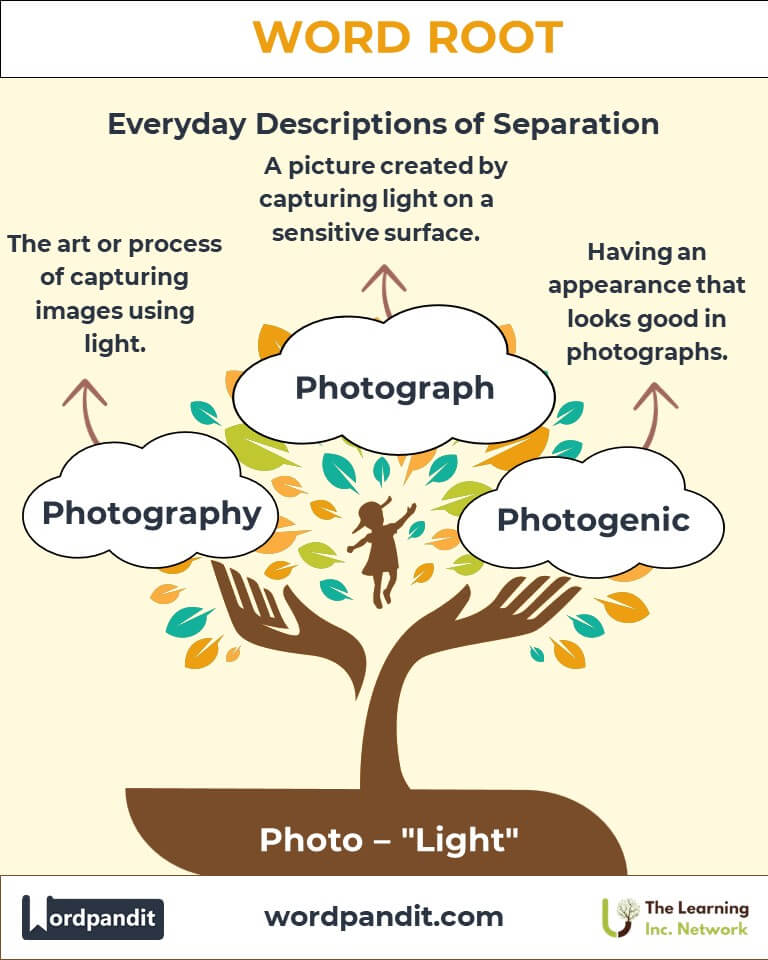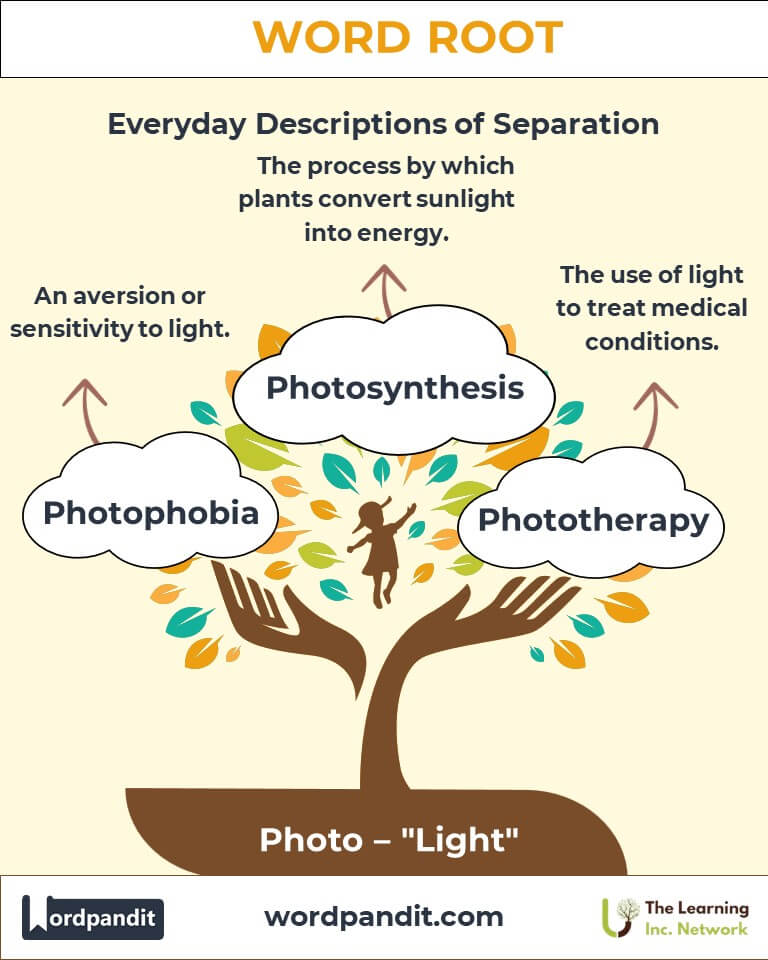Photo: Illuminating the Power of Light in Language and Life
Byline:
Explore the fascinating world of the word root "photo," derived from the Greek word "phos," meaning "light." From photography to phototropism, this root has illuminated a diverse range of words across science, technology, and art.

Table of Contents
- Introduction: The Essence of "Photo"
- Etymology and Historical Journey
- Mnemonic: Unlocking the Power of "Photo"
- Common "Photo"-Related Terms
- "Photo" Through Time
- "Photo" in Specialized Fields
- Illustrative Story: "Photo" in Action
- Cultural Significance of the "Photo" Root
- The "Photo" Family Tree
- FAQs about the "Photo" Word Root
- Test Your Knowledge: "Photo" Mastery Quiz
- Conclusion: The Everlasting Glow of "Photo"
Introduction: The Essence of "Photo"
What comes to mind when you hear the term "photo"? Likely, you envision a photograph—a moment frozen in time through the interplay of light and technology. The root "photo" (pronounced FO-toh), from the Greek word "phos" meaning "light," serves as the linguistic foundation for numerous words that relate to illumination, imagery, and energy. In disciplines ranging from art to biology, "photo" continues to shine as a source of discovery and creativity.

Etymology and Historical Journey
The journey of "photo" begins in ancient Greece, where "phos" was used to describe natural light. With the Renaissance and advancements in optics, the concept of light gained prominence, leading to scientific breakthroughs like Isaac Newton's exploration of light refraction. The prefix "photo-" became widely adopted in the 19th century, particularly with the invention of photography (light-writing) and photochemistry, revolutionizing art and science.
Mnemonic: Unlocking the Power of "Photo"
To remember "photo," picture a sunflower turning its face toward the sun, embracing its light.
Mnemonic:
"Photo—where light brings life and focus to every corner."
Common "Photo"-Related Terms
- Photography: The art or process of capturing images using light.
Example: "The photographer captured stunning landscapes using natural light." - Photosynthesis: The process by which plants convert sunlight into energy.
Example: "Photosynthesis is essential for life on Earth, powering the food chain." - Photograph: A picture created by capturing light on a sensitive surface.
Example: "She framed her favorite photograph of a sunset." - Photophobia: An aversion to light, often due to medical conditions.
Example: "Migraine sufferers often experience photophobia as a symptom." - Photogenic: Having an appearance that looks good in photographs.
Example: "Her photogenic smile was perfect for the magazine cover."
"Photo" Through Time
- Photography (1839): With the invention of the daguerreotype, photography became a revolutionary way to capture reality.
- Photovoltaic Cells (1950s): The development of solar panels highlighted the ability to convert light into energy.
"Photo" in Specialized Fields
- Art and Media: Photography revolutionized visual storytelling and documentation.
- Biology: Photosynthesis explains the role of light in sustaining ecosystems.
- Technology: Photovoltaic cells drive renewable energy innovations.
- Medicine: Phototherapy uses light to treat conditions like jaundice and seasonal affective disorder.
Illustrative Story: "Photo" in Action
Lila, a budding biologist, marveled at the vibrant green leaves of plants under sunlight. During a class project, she set up an experiment to observe photosynthesis. Using colored lights, she discovered how different wavelengths affect plant growth, shedding "light" on the intricate relationship between plants and the sun. Her findings inspired her to explore renewable energy, proving how the power of "photo" shapes both nature and innovation.
Cultural Significance of the "Photo" Root
The "photo" root symbolizes humanity's fascination with light. From ancient sun worship to the modern digital photography era, light remains a metaphor for clarity, life, and inspiration. Festivals like Diwali and artistic expressions like Van Gogh’s "Starry Night" demonstrate the cultural impact of light and illumination.

The "Photo" Family Tree
- Phos (Greek): Light.
- Phosphorescence: Light emitted without heat.
- Lux (Latin): Light.
- Lucid: Clear and easy to understand.
- Lumin (Latin): Light or shine.
- Illuminate: To light up.

FAQs About the "Photo" Word Root
Q: What does "photo" mean, and what is its origin?
A: The root "photo" comes from the Greek word "phos," meaning "light." It is used as a prefix in English to denote something related to light, such as photography (writing with light) or photosynthesis (using light to synthesize energy).
Q: How is "photo" used in everyday language?
A: The term appears in common words like "photograph," meaning a picture captured using light, and "photogenic," referring to something or someone that looks good in photographs. These examples illustrate the root's centrality to visual culture and communication.
Q: What is photosynthesis, and why is it important?
A: Photosynthesis is the process by which plants, algae, and some bacteria use sunlight to convert carbon dioxide and water into glucose and oxygen. It is fundamental for life on Earth, as it provides food and oxygen, forming the basis of most ecosystems.
Q: How does "photo" relate to renewable energy?
A: The prefix "photo" appears in terms like photovoltaic cells, which convert sunlight into electricity. This technology is the cornerstone of solar power, a key renewable energy source that helps reduce carbon emissions.
Q: Why is "phototherapy" important in medicine?
A: Phototherapy uses light to treat conditions such as neonatal jaundice, seasonal affective disorder (SAD), and certain skin conditions like psoriasis. It demonstrates how light can have therapeutic effects on human health.
Test Your Knowledge: "Photo" Word Root Quiz
1. What does the root "photo" mean?
2. Which term describes the process plants use to make energy?
3. What does "photogenic" mean?
4. What is the scientific term for light-based electricity generation?
5. Which field uses phototherapy?
Conclusion: The Everlasting Glow of "Photo"
The root "photo" reminds us of light's transformative power, shaping our understanding of life, art, and technology. As we innovate and explore new frontiers, "photo" remains a guiding light in language and discovery. Embrace its legacy, and let your curiosity shine brightly!












